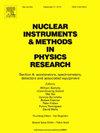Development of thin-gap GEM-μRWELL hybrid detectors
IF 1.5
3区 物理与天体物理
Q3 INSTRUMENTS & INSTRUMENTATION
Nuclear Instruments & Methods in Physics Research Section A-accelerators Spectrometers Detectors and Associated Equipment
Pub Date : 2025-06-28
DOI:10.1016/j.nima.2025.170791
引用次数: 0
Abstract
Micro Pattern Gaseous Detectors (MPGDs) are used for tracking in High Energy Physics and Nuclear Physics because of their large area, excellent spatial resolution capabilities and low cost. However, for high energy charged particles impacting at a large angle with respect to the axis perpendicular to detector plane, the spatial resolution degrades significantly because of the long trail of ionization charges produced in clusters all along the track in the drift region of the detector. The long ionization charge trail results in registering hits from large number of strips in the readout plane which makes it challenging to precisely reconstruct the particle’s position using simple center of gravity algorithm. As a result, the larger the drift gap, the more severe the deterioration of spatial resolution for inclined tracks. For the same reason, the position resolution is also severely degraded in a large magnetic field, where the Lorentz E B effect causes the ionization charges to follow a curved and longer path in the detector gas volume. In this paper, we report on the development of thin-gap MPGDs as a way to maintain excellent spatial resolution capabilities of MPGD detectors over a wide angular range of incoming particles. In a thin-gap MPGD, the thickness of the gas volume in the drift region is reduced from typically 3 mm to 1 mm or less. We present preliminary test beam results demonstrating the improvement in spatial resolution from 400 m with a standard 3 mm gap RWELL prototype to 140 m with a double amplification GEM-RWELL thin-gap hybrid detector. We also discuss the impact of a thin-gap drift volume on other aspects of the performance of MPGD technologies such as the efficiency and detector stability.
薄间隙GEM-μRWELL混合探测器的研制
微模式气体探测器(MPGDs)因其面积大、空间分辨率高、成本低等特点,被广泛应用于高能物理和核物理领域。然而,当高能带电粒子与探测器平面垂直轴呈大角度碰撞时,由于在探测器漂移区沿轨迹产生的簇状电离电荷的长尾,空间分辨率明显下降。由于长时间的电离电荷尾迹导致在读出平面上记录大量条带的命中,这给用简单的重心算法精确重建粒子位置带来了挑战。因此,漂移间隙越大,倾斜轨道的空间分辨率下降越严重。由于同样的原因,在大磁场中,位置分辨率也严重下降,洛伦兹E × B效应导致电离电荷在探测器气体体积中沿着弯曲的更长的路径运动。在本文中,我们报告了薄间隙MPGD的发展,作为一种保持MPGD探测器在大角度范围内入射粒子的优异空间分辨率的方法。在薄间隙MPGD中,漂移区气体体积的厚度通常从~ 3mm减小到~ 1mm或更小。我们提出了初步的测试光束结果,表明空间分辨率从标准3mm间隙μRWELL原型的~ 400 μm提高到双放大GEM-μRWELL薄间隙混合探测器的~ 140 μm。我们还讨论了薄间隙漂移体积对MPGD技术性能的其他方面的影响,如效率和探测器稳定性。
本文章由计算机程序翻译,如有差异,请以英文原文为准。
求助全文
约1分钟内获得全文
求助全文
来源期刊
CiteScore
3.20
自引率
21.40%
发文量
787
审稿时长
1 months
期刊介绍:
Section A of Nuclear Instruments and Methods in Physics Research publishes papers on design, manufacturing and performance of scientific instruments with an emphasis on large scale facilities. This includes the development of particle accelerators, ion sources, beam transport systems and target arrangements as well as the use of secondary phenomena such as synchrotron radiation and free electron lasers. It also includes all types of instrumentation for the detection and spectrometry of radiations from high energy processes and nuclear decays, as well as instrumentation for experiments at nuclear reactors. Specialized electronics for nuclear and other types of spectrometry as well as computerization of measurements and control systems in this area also find their place in the A section.
Theoretical as well as experimental papers are accepted.

 求助内容:
求助内容: 应助结果提醒方式:
应助结果提醒方式:


